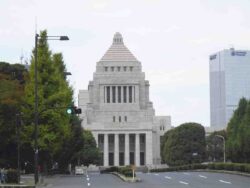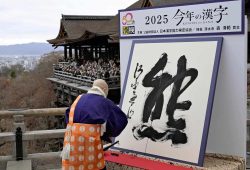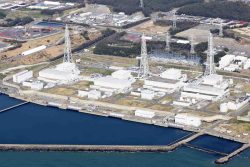JCG Eyes Large Drones for Rescue Operations; Testing Capabilities for Possible Implementation This Year
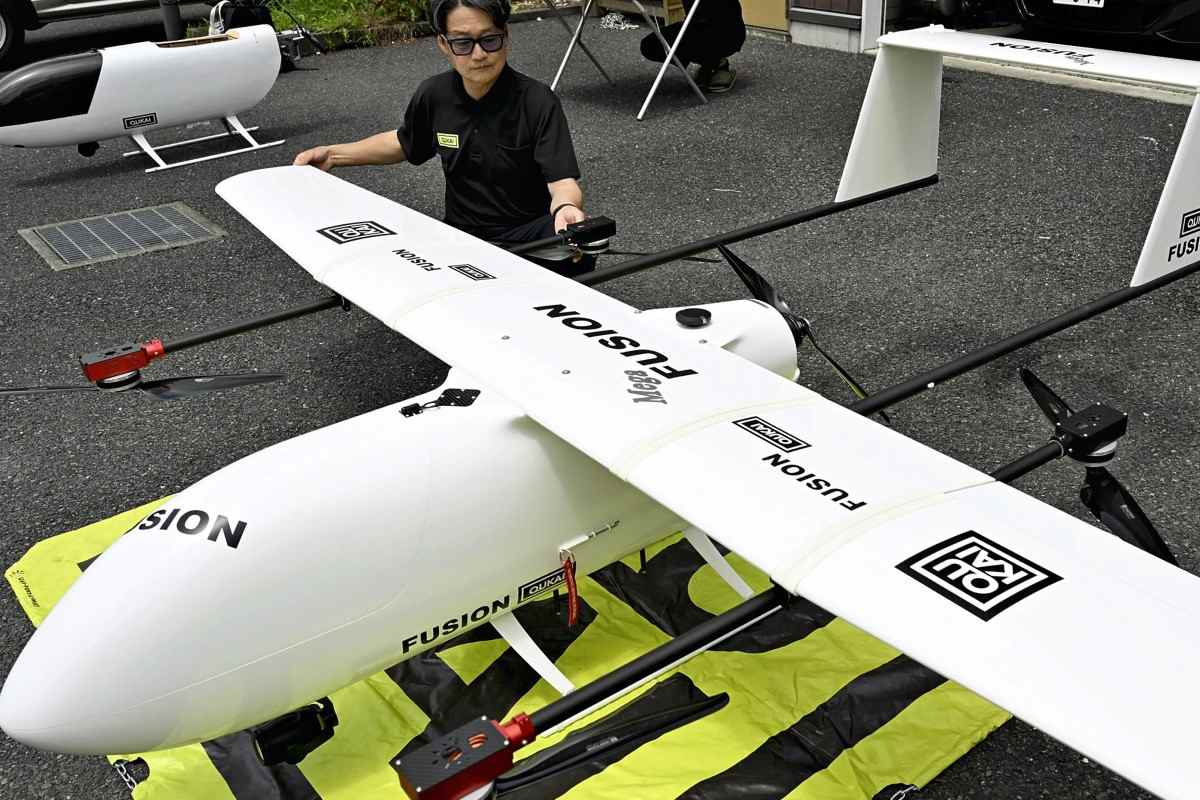
Naoki Morita, chief marketing officer at Qu-Kai Inc., discusses the features of his company’s largest drone model in Tokyo.
1:00 JST, July 1, 2024
The Japan Coast Guard will conduct its first test flight of a large drone at sea this fiscal year, aiming for the official implementation of such aircraft, The Yomiuri Shimbun has learned.
Large drones are expected to be used for a wide range of JCG operations. The JCG aims to introduce the aircraft at the earliest possible date, according to sources.
Large drones are light enough to be transported on land and do not require a runway to take off or land. There are many large models which can fly over the sea for several hours and are more durable than smaller drones.
The JCG has already begun using U.S.-made unmanned air vehicles. For the planned implementation of large drones, the coast guard may be supplied by a domestic maker instead, as Japanese companies have already developed and commercialized such products.
Patrol vessels can be equipped with large drones. In case of an incident occurring near a patrol vessel, the drone could be dispatched to the scene first to help gather information on the situation as quickly as possible.
The drone could be placed aboard survey vessels or at JCG bases away from air stations. This would make it easier for the coast guard to manage lighthouses and other navigation beacons. It could also be used to observe changes in topography along coastlines, as was done following the Jan. 1 earthquake that devastated the Noto Peninsula in Ishikawa Prefecture.
The JCG is considering conducting its first test flight this summer at the earliest. A large drone would be expected to take off from and land on the helicopter deck of a large patrol vessel. The JCG will likely check if the drone could make stable flights in the face of strong winds over the sea or safely return to the deck after taking off as the ship navigates through waves.
The JCG established a project team in April consisting of about 10 officials to study the introduction of large drones. Efforts are currently underway to select a manufacturer to take part in the test.
In December 2022, the government decided on a policy to strengthen the nation’s maritime security capabilities. This change was prompted by China’s aggressive maritime expansion, among other factors.
The policy identified six areas that should be strengthened, with one of them described as “solid foundations to carry out necessary operations.” For this purpose, the government “will promote the use of new technology to carry out operations efficiently and effectively, as well as saving labor,” the policy said.
In October 2022, the JCG began operating a Sea Guardian unmanned air vehicle at its base in Hachinohe, Aomori Prefecture. Produced by General Atomics in the United States, the aircraft have a wingspan of 24 meters and weigh 2.2 tons each, making them up to 10 times the size of most large drones. These vehicles can fly for over 24 hours, meaning that they can travel the perimeter of Japan’s exclusive economic zone.
The Sea Guardian’s surveillance capabilities enable it to read the name of a vessel from up to 15 kilometers away.
The JCG got two more Sea Guardians in May 2023, and the total number is expected to be brought to five next fiscal year.
Flying lower, longer
While many drones have rotary wings, fixed-wing vehicles have also been developed in Japan and overseas.
“Large drones can fly at a lower altitude than manned air vehicles, so they can get better data from their missions to film and survey [the topography],” said Naoki Morita, chief marketing officer at Qu-Kai Inc., a Tokyo-based manufacturer. “They’re also more efficient, which means they can fly for longer than smaller drones. These are the strengths of larger drone.”
The company’s largest model is named Qukai Mega Fusion 3.5, and is primarily made of fiberglass-reinforced plastic. With a 3.5-meter wingspan and weighing 12 kilograms, this model can vertically take off and land using electric rotor blades. It is also equipped with a gasoline engine that is in the testing phase for horizontal takeoffs using its propeller.
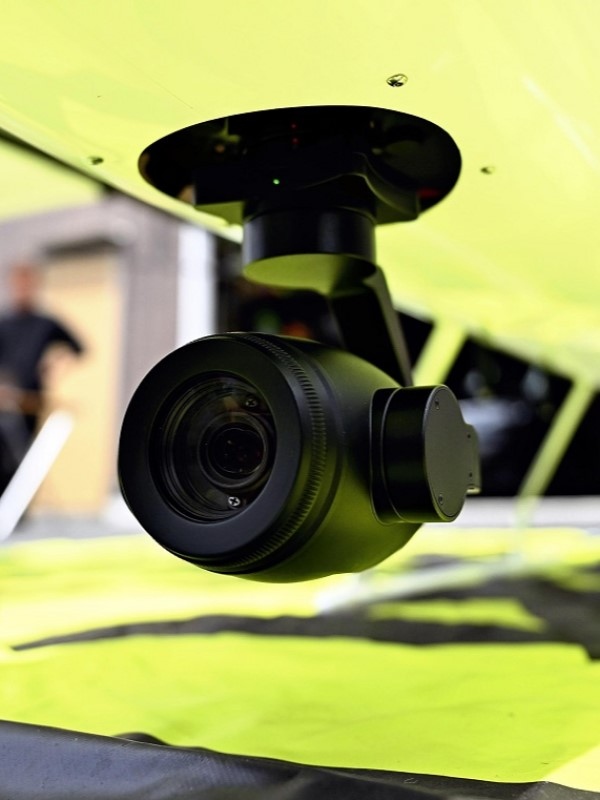
A high-performance camera is set on the lower part of the aircraft, allowing the operator to remotely check footage the vehicle takes.
Combining the two flight methods, Qukai Mega Fusion 3.5 is expected to fly for as long as four hours while carrying a load of up to 10 kilograms. This model costs several million yen per unit, according to Morita.
Qukai Mega Fusion 3.5 can be operated remotely using a computer or tablet, while video footage captured by its 30x lens and a nighttime infrared camera can be checked in real time from the ground.
When a test flight was conducted at night around Mt. Usu in Hokkaido based on a scenario of a possible eruption, the drone used a laser to survey an area of more than 700,000 square meters in 10 minutes.
Qukai Fusion 2.4, another model from the manufacturer with a 2.4-meter wingspan, also took part in the simulation, flying for 20 kilometers to and from the mountain to capture images of its surface.
"Society" POPULAR ARTICLE
-

M4.9 Earthquake Hits Tokyo, Neighboring Prefectures
-

M7.5 Earthquake Hits Northern Japan; Tsunami Waves Observed in Hokkaido, Aomori and Iwate Prefectures
-

Tsukiji Market Urges Tourists to Avoid Visiting in Year-End
-

Beloved Cat Stationmaster Nitama in Wakayama Pref. Passes Away at 15
-
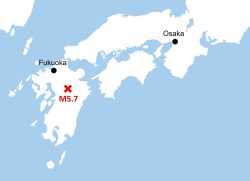
M5.7 Earthquake Hits Japan’s Kumamoto Pref., Measuring Upper 5 Intensity, No Tsunami Expected
JN ACCESS RANKING
-

Japan’s Hopes for Seafood Exports Shot Down in China Spat
-

Keidanren Chairman Yoshinobu Tsutsui Visits Kashiwazaki-Kariwa Nuclear Power Plant; Inspects New Emergency Safety System
-

Japan to Charge Foreigners More for Residence Permits, Looking to Align with Western Countries
-

Imports of Rare Earths from China Facing Delays, May Be Caused by Deterioration of Japan-China Relations
-

Japan Exports Rise in October as Slump in U.S. Sales Eases








